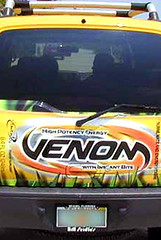According to a recent The New York Times story, thousands of motorists are already signing up to have their cars and trucks wrapped in advertisements. While the story said the mentions a stipend of up to $800 a month, FreeCar Media only includes for up to $400 per month on its Web site, which covers some car payments.
In some cases however, drivers may not have to think about payments at all. Some receive a new car to use for about two years in lieu of a cash stipend (insurance and gas is still the responsibility of the driver). As an interesting side note, applicants seem strongly encouraged to consider changing their policy to Progressive, creating a guerilla marketing campaign of sorts within a guerilla marketing campaign.
This might trump the old saying “never look a gift horse in the mouth,” but perhaps just a bit. Pause long enough to know what you are filling out as wrapping the vehicle might not be the only criteria. Those chosen are also asked to refrain from smoking, littering, or swearing in their vehicle (easy); attend a monthly “influencer event” where they hand out samples or coupons (moderate); and send reports and frequency updates that include photos of where the cars have been (hard).
Applicants are not always selected because it is the advertisers who choose the drivers they want. This decision, according to the company, is largely based on how much information the applicant is willing to provide. However, whether the company uses this information for other marketing purposes is also not clear.
What is clear is that it has worked for some products and companies: Pringles, HBO, International House of Pancakes, and Tang are all among them. In the Pringles case study from 2001, a fleet of 25 consumer-owned vehicles were wrapped in Atlanta.
At the inception of that campaign, all 25 vehicles lined up in front of Turner Stadium for a Braves vs. Mets game. All the drivers and their families (which consisted primarily of soccer moms/dads), sat in the back of their vehicles passing out free Pringles samples to 52,000 baseball fans. It was not clear whether the families received additional compensation for their time at the game or if the wraps were removed at the end of the 3-month campaign.
What is starting to interest me is how far consumers will allow advertising to permeate their lives and what are the long-term consequences to the dilution of the message. Already, some studies suggest it takes well over 200 impressions to have the same impact 80 impressions did just a few years ago. (And this doesn’t include any opt-in mobile phone advertising programs that are likely to be introduced in the future.)
Still, mobile billboards (if not consumer cars) does make sense for some advertisers. Although FreeCar Media estimates almost 70,000 other motorists and pedestrians will see the advertisement daily, most mobile billboards offer better reach along planned routes (and use much more conservative numbers). We’ve arranged some in the past; they are exceptionally well suited to targeted location/route advertising.
So how do you top this? If you want some ideas, visit Las Vegas where advertising wraps have reached new heights. EliteMedia, which specializes in outdoor advertising, has placed huge advertisements on several iconic hotels, including Mandalay Bay and the Luxor. You can see some of the recent wraps on their blog.
Seeing an ad cover an entire building seems fun, or in some cases, um, interesting. It also makes you wonder. If your niche blog doesn’t excite people, maybe you can consider how much the average residential garage door might be worth, a yard sign during peak political season, or perhaps spiffy ad wraps for frequent fliers.



















3 comments:
They can wrap my whole house if they want to pay me enough. Garage too.
Good job, Rich. Thanks.
I'll do it for the Wii! Or a Porsche (if they give me the Porsche).
Well, I think you both answered one question. If the price it right, get out the body art. ;)
All my best,
Rich
Post a Comment